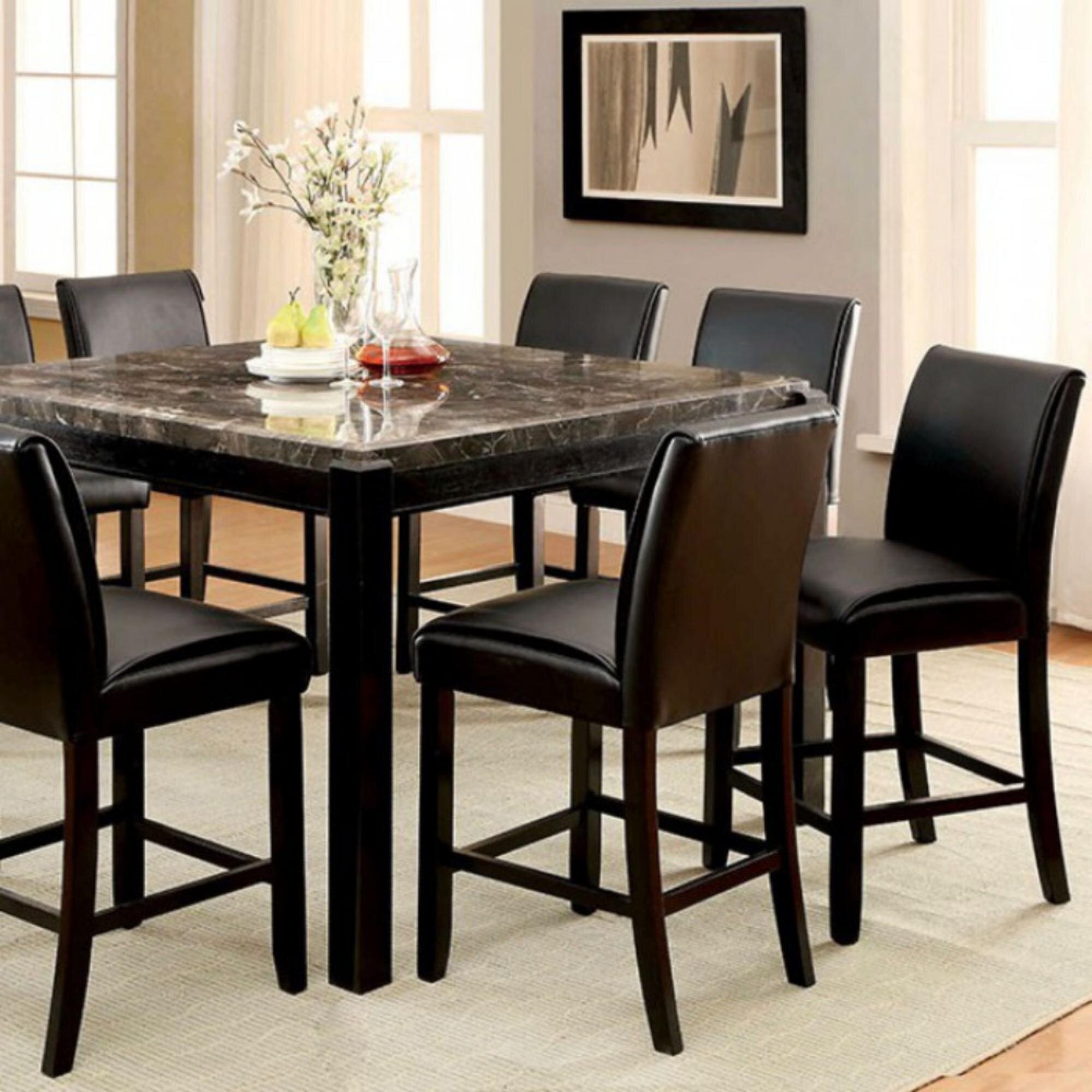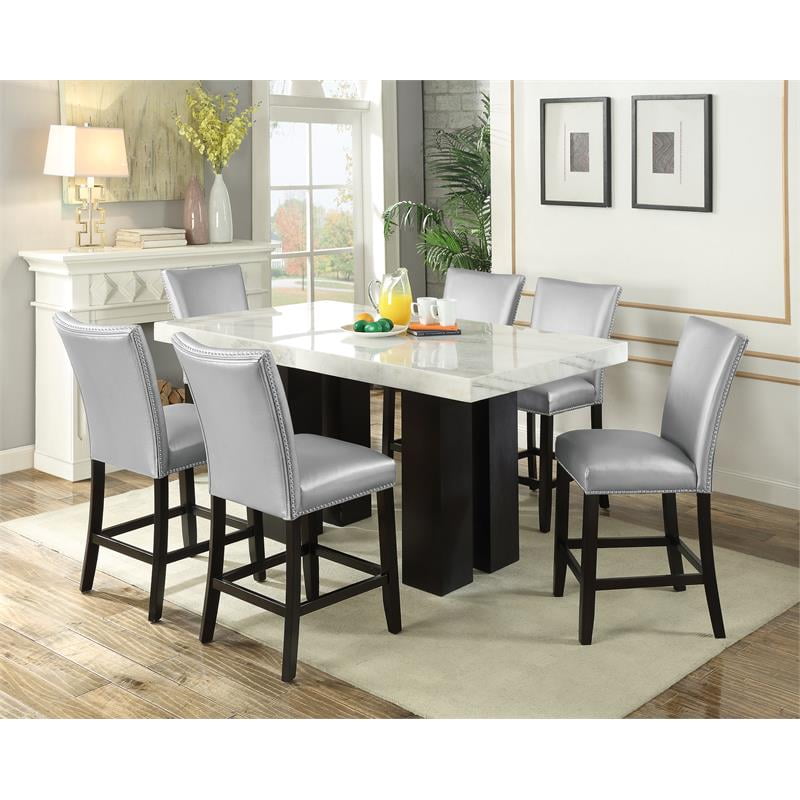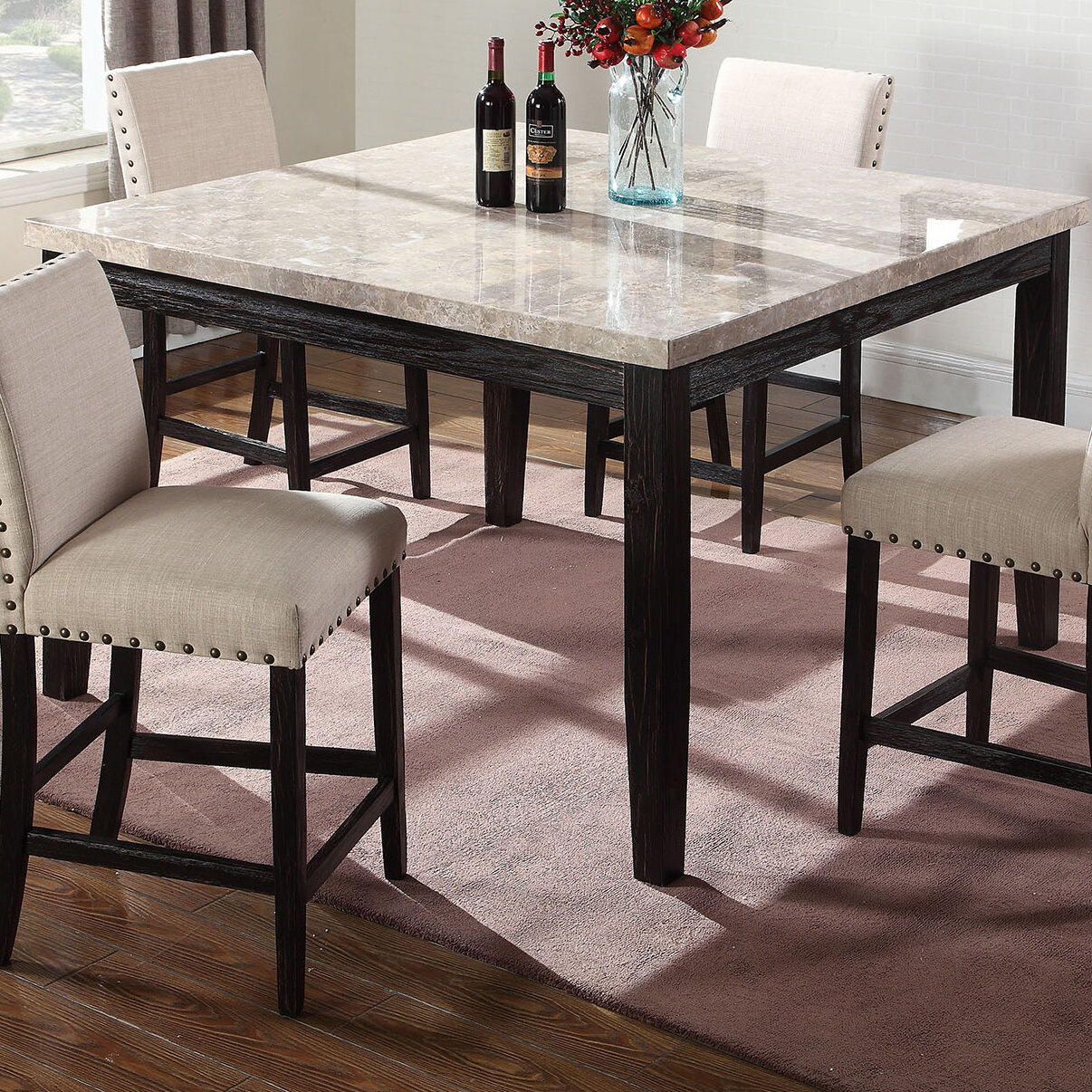Marble countertop dining tables have long been synonymous with elegance and luxury, making them a popular choice for those looking to enhance their dining spaces. A marble table serves as more than just a functional piece; it becomes a statement of style and sophistication. Marble, being a natural stone, has a unique beauty that is hard to replicate with other materials. The veining patterns and color variations in marble are created by nature over thousands of years, ensuring that no two marble countertops are exactly alike. This uniqueness adds to the appeal of marble tables, as they offer a distinct and personalized aesthetic to any dining room.
One of the key advantages of a marble countertop dining table is its durability. Marble is a dense material, capable of withstanding daily wear and tear. It is heat-resistant, which means you can place hot dishes on it without worrying about damage. However, it’s important to note that while marble is sturdy, it’s not impervious to damage. Marble is softer than granite, which makes it more susceptible to scratches, chips, and etching from acidic substances like lemon juice or vinegar. Therefore, care must be taken to protect the surface from sharp objects and acidic spills.
Another aspect that makes marble countertop dining tables desirable is their versatility in design. Marble comes in various colors, from classic white with grey veining to deep black, green, pink, and even red. This variety allows homeowners and interior designers to choose a marble table that complements the overall décor of the dining space. Whether your dining room has a modern, minimalist vibe or a more traditional, ornate style, there’s a marble option that can seamlessly blend in or stand out as a focal point.
Maintenance is a significant consideration when owning a marble countertop dining table. Unlike synthetic materials, marble requires regular care to maintain its luster and prevent damage. Sealing the marble surface periodically is crucial to protect it from stains and moisture. A high-quality sealant can help create a barrier against liquids and reduce the risk of etching. However, even with a sealant, it’s essential to wipe up spills immediately and avoid using harsh cleaning agents that can erode the protective layer or dull the stone’s finish.

When it comes to cleaning, a soft cloth and a mild, pH-neutral cleaner are your best allies. Avoid using abrasive sponges or acidic cleaners, as these can cause micro-scratches and etching. For daily maintenance, simply wiping the surface with a damp cloth is usually sufficient. If the table is exposed to heavy use, consider placing mats or coasters under hot dishes and glasses to prevent direct contact with the marble. Additionally, using placemats or tablecloths during meals can further protect the surface from scratches and spills.
The longevity of a marble countertop dining table is another factor that adds to its appeal. With proper care, a marble table can last for decades, if not longer. The natural stone’s durability means that it can withstand the test of time, becoming a cherished heirloom passed down through generations. However, the natural aging process of marble can lead to a patina developing on the surface, which some people find adds to the character of the stone. This patina, while not as polished as the original finish, can give the marble a softer, more lived-in appearance.
In addition to its aesthetic and functional benefits, a marble countertop dining table can also increase the value of your home. Marble is often associated with luxury, and having a marble table in your dining room can elevate the overall perception of your home’s interior. This can be particularly advantageous if you ever decide to sell your property, as potential buyers may be drawn to the timeless elegance of marble. Investing in a high-quality marble table can be seen as an investment in your home’s future resale value.

However, it’s important to consider the weight of a marble countertop dining table. Marble is significantly heavier than other materials like wood or glass, which can make the table difficult to move. If you anticipate needing to rearrange your dining space frequently, this could be a drawback. Additionally, the weight of the marble may require reinforced flooring, especially in older homes where the structural integrity of the floors may be a concern. Before purchasing a marble table, it’s wise to assess whether your dining room floor can support the weight without any issues.
The cost of a marble countertop dining table is another consideration. Marble is one of the more expensive materials available, and the price can vary widely depending on the quality, size, and type of marble chosen. While there are more affordable options on the market, they may not offer the same level of durability or aesthetic appeal as higher-end marble. For those on a budget, it may be worth considering whether the investment in marble is justified by the benefits it offers. If you’re looking for a statement piece that will stand the test of time, a marble table can be well worth the cost.
Sustainability is also an important factor to consider. Marble is a natural, non-renewable resource, and its extraction and processing can have significant environmental impacts. If sustainability is a priority for you, it’s important to research the sourcing of the marble and the environmental practices of the manufacturer. Some companies offer marble that has been ethically sourced, with a focus on minimizing environmental damage. Additionally, choosing a high-quality marble table that will last for decades can be seen as a more sustainable choice compared to lower-quality tables that may need to be replaced more frequently.

Another aspect to consider is the potential for repairs. While marble is durable, it’s not indestructible. Chips, cracks, and stains can occur, and it’s important to know that repairing marble can be a delicate and costly process. Professional repair services may be required to restore the table to its original condition, and in some cases, the damage may be irreversible. To minimize the risk of damage, it’s crucial to handle the table with care and avoid placing heavy or sharp objects directly on the surface.
Lastly, the aesthetic impact of a marble countertop dining table cannot be overstated. Marble has an inherent ability to catch and reflect light, which can brighten up a dining room and create a sense of space. The smooth, polished surface of marble adds a touch of sophistication to any setting, making it an ideal choice for both formal and casual dining environments. Whether you’re hosting a dinner party or enjoying a quiet family meal, a marble table can make the experience feel more luxurious and special.

Common Mistakes to Avoid
One of the most common mistakes people make with marble countertop dining tables is failing to seal the surface regularly. Sealing is essential to protect the marble from stains and moisture, and skipping this step can lead to permanent damage. Another mistake is using harsh or acidic cleaning products, which can cause etching and dull the stone’s finish. Always opt for a pH-neutral cleaner designed specifically for marble.
Additionally, placing hot items directly on the marble without a trivet or coaster can result in heat stains, which are difficult to remove. It’s also important to avoid dragging heavy objects across the table, as this can cause scratches or chips. Lastly, some people underestimate the weight of marble and don’t properly assess their flooring’s ability to support it, leading to potential structural issues.

How do I clean a marble countertop dining table?
Cleaning a marble countertop dining table requires a gentle approach. Use a soft, damp cloth to wipe the surface daily. For deeper cleaning, a pH-neutral cleaner specifically designed for marble should be used. Avoid acidic or abrasive cleaners as they can damage the marble. After cleaning, make sure to dry the surface completely to prevent moisture from seeping into the stone.
Do marble tables stain easily?
Marble is porous, so it can absorb liquids that lead to staining. To prevent this, it’s essential to seal the marble regularly and wipe up any spills immediately. Acidic substances like wine, lemon juice, and vinegar are particularly harmful, as they can cause both staining and etching. Using coasters and placemats can help protect the surface from potential stains.
How often should I seal my marble countertop dining table?
The frequency of sealing depends on the usage and the type of marble. Typically, sealing should be done every 6 to 12 months. To check if your marble needs resealing, sprinkle a few drops of water on the surface. If the water beads up, the seal is still intact. If it absorbs into the marble, it’s time to reseal.

Can I place hot dishes directly on a marble table?
While marble is heat-resistant, placing hot dishes directly on the surface is not recommended. Extreme heat can cause discoloration or heat stains on the marble. Always use trivets or coasters under hot dishes to protect the marble from potential damage.
Is marble a good choice for families with children?
Marble can be a beautiful addition to a family dining space, but it requires more maintenance compared to other materials. Families with young children should be mindful of potential spills and scratches. Using tablecloths, placemats, and coasters can help protect the marble, but it’s important to be prepared for the upkeep involved in maintaining its pristine condition.
What should I do if my marble table gets scratched?
Minor scratches on marble can sometimes be buffed out with a marble polishing powder and a soft cloth. For deeper scratches, it may be necessary to consult a professional. They can use specialized tools to restore the marble’s smooth surface. To prevent future scratches, avoid dragging objects across the table and consider using protective mats.

Gladstone I Gray Marble Top Counter Height Dining Table

Wilber Counter Height Dining Table

Camila 7 Piece Counter Height Dining Set

Related articles:
- Italian Marble Countertops
- Modern Marble Countertops
- Marble Countertops Design
- Refinishing Cultured Marble Countertops
- White Marble Countertops
- Marble Countertops Backsplash
- DIY Refinishing Cultured Marble Countertops
- Marble Countertops In Bathrooms
- Cultured Marble Countertops
- Gray Kitchen Cabinets Marble Countertops